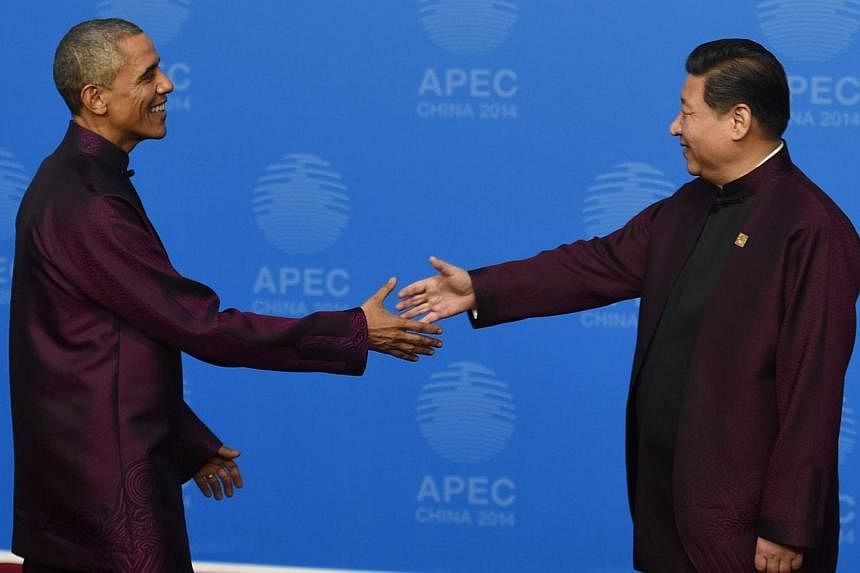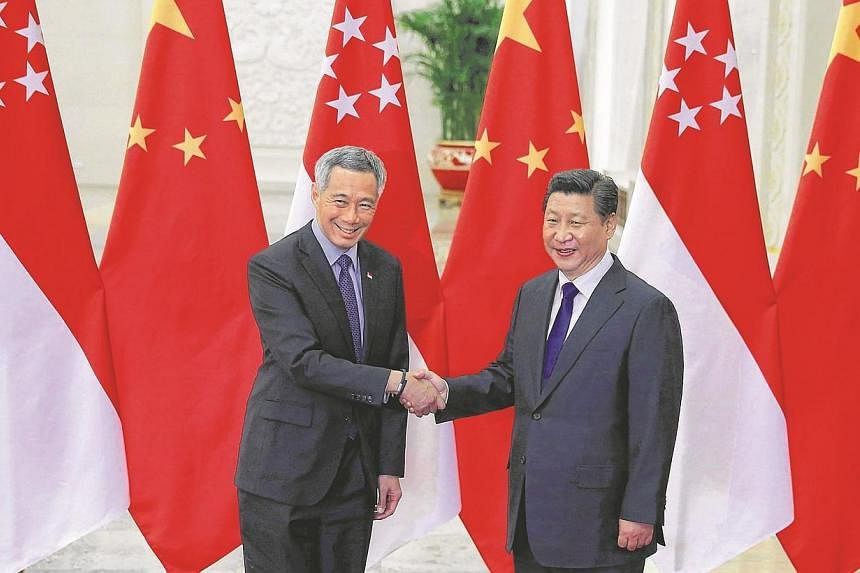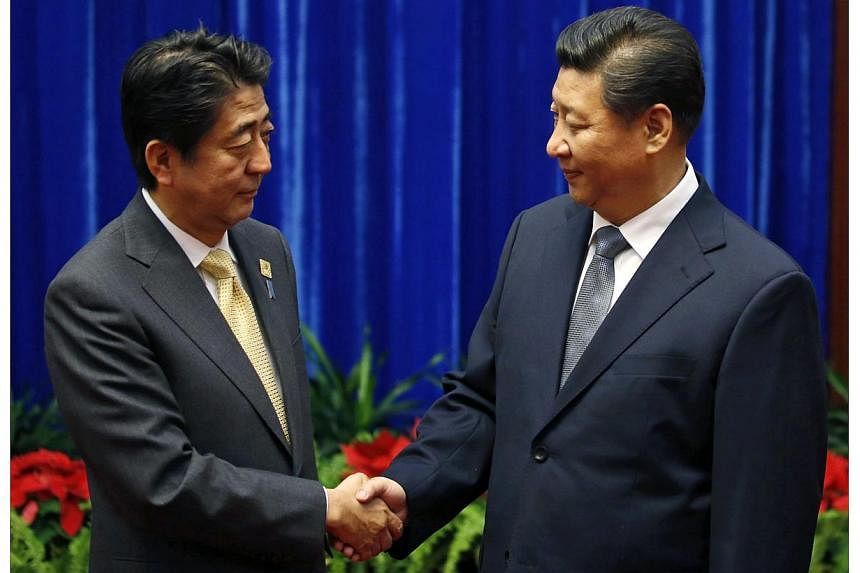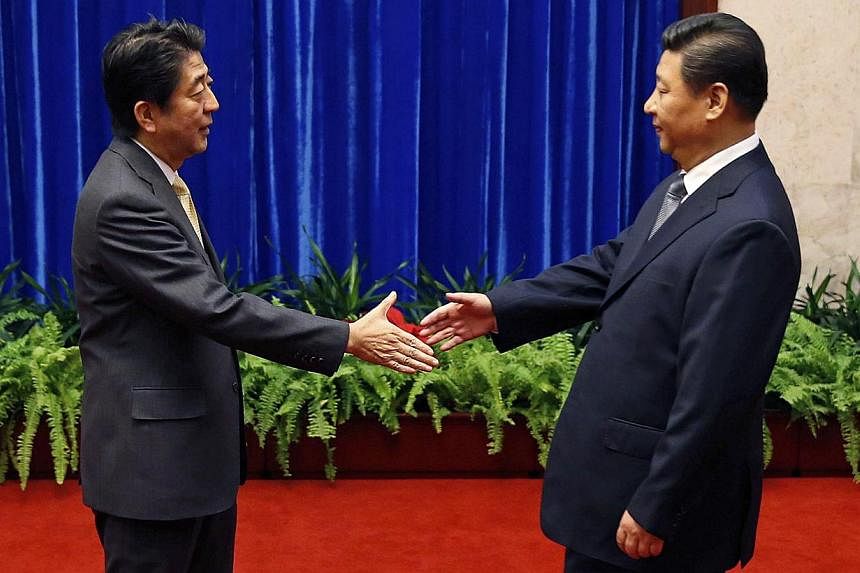Talk of how Sino-Japanese relationships had taken a turn for the better dominated the Asia-Pacific Economic Cooperation (Apec) Summit on Monday as China's President Xi Jinping and Japan's Prime Minister Shinzo Abe met one-on-one for the first time, yet an awkward handshake between the two leaders in front of cameras attracted top billing as well.
The image of a stiff, unsmiling Mr Xi greeting Mr Abe at Beijing's Great Hall of the People prompted a whirlwind of speculation of how the meeting - which Mr Abe described as "gentlemenlike" - had transpired.
International relations watchers and local experts on body language spoke to The Straits Times and give their take on the landmark affair.
Dr Li Mingjiang is an associate professor and coordinator of the China Programme at S. Rajaratnam School of International Studies, Nanyang Technological University
Dr Li said Mr Xi's body language clearly indicated that he does not like Mr Abe and wanted the media to take notice of his attitude toward the Japanese Prime Minister.
He added: "Xi probably wanted to send a signal to Abe that the four-point joint statement (a consensus aimed at improving bilateral relations) had not entirely satisfied China's demands and he still needs to do more to gain China's trust."
Dr Li also suggested that Mr Xi wanted Mr Abe to know that the meeting does not mean the end of the tense ties between the two countries, and that China would continue to be tough on Japan on the Diaoyu islands dispute as well as the bitter legacy of Japan's occupation.
Dr Lam Peng Er is a political scientist from the National University of Singapore's East Asian Institute
Dr Lam thinks that both men appeared very stiff in the video, with Mr Xi maintaining a poker face and failing to reply to Mr Abe's greetings.
He said: "The atmosphere of the meeting appeared to be rather chilly, but it is still important symbolically and will pave the way for lower level ministers and bereaucrats to hold dialogues on issues of common interest.
It remains to be seen if Abe will visit the Yasukani Shrine during his remaining tenure as Prime Minister - if he does, then Sino-Japanese relations will hit rock bottom again and it is unlikely Xi will meet him again in office."
Dr Heng Yee Kuang is an associate professor (international relations) and assistant dean (research) at the Lee Kuan Yew School of Public Policy, National University of Singapore
Dr Heng felt that Mr Xi has to adopt a cautious approach when it comes to maintaining his image in front of the Chinese people.
"He probably doesn't want to look 'too friendly', only to lose face if Abe were to visit Yasukuni Shrine again," he said.
But Dr Heng also noted that the setting probably moved this meeting along faster than it would have taken if both countries were left on their own, and the challenge now was to ensure it was not done simply for Apec.
Calling it a "small, positive step at least", he observed that the awkward camera moment had been borne out of the necessity for both men to appear together.
Christian Chua is an expert on body language and leads his own Christian Chua Training Academy
Based on past videos of Mr Xi, Mr Chua thought that the Chinese leader appeared "totally cold".
"He (Xi) is not known for giving broad smiles, but he did at least afford smiles to other leaders like US President Barack Obama. It's a huge red flag, that even though the pair shared a good handshake, Xi's body language and facial expression was not congruent.
"It felt as if he was merely going through the motions."
Teo Ser Lee is the founder and director of Protocol Academy, which provides professional etiquette and protocol training
Ms Teo preferred to focus on their handshake, which she said looked very firm and professional.
She commented: "Xi usually appears stiff and stern in photos, so people could be reading too much into his expression. That said, the way he stood was not very friendly, as he was not facing Abe. I saw how he greeted PM Lee Hsien Loong and there was a marked difference."
She also pointed out that Mr Xi's demeanour while greeting the rest of Mr Abe's entourage later in the video, was not very positive.
She added: "Instead of being a forthcoming and sincere host, he merely stood there and proferred half-hearted handshakes to them."
John Sih runs professional consultancy Accent Training Consultants and is also a body language expert
Mr Sih said Mr Abe cleared showed a more positive approach towards Mr Xi during the initial exchange, maintaining eye contact throughout. Mr Xi, in contrast, had a resentful look on his face.
"During the handshake, Abe also appeared to exert more pressure on his grip compared to Xi, with the Chinese leader looking away first. It showed that he was not reciprocating Abe's grace and willingness to communicate."
The duo's frosty meeting appeared to have thawed as the day wore on, however, as both leaders - along with their wives - were photographed at the Apec Summit banquet smiling for cameras as they once again shook hands.











